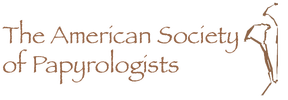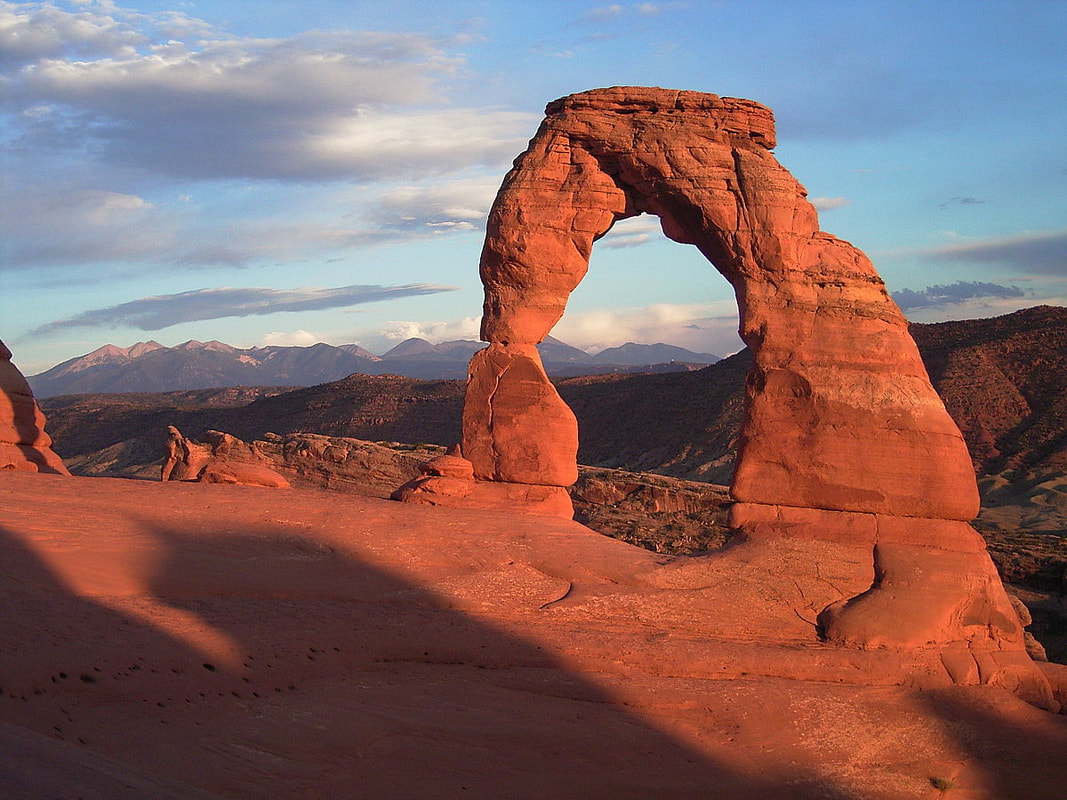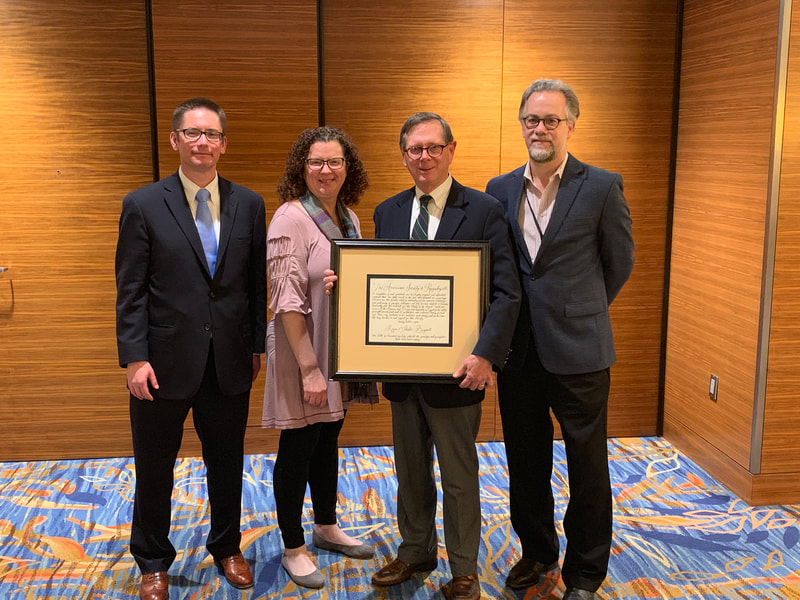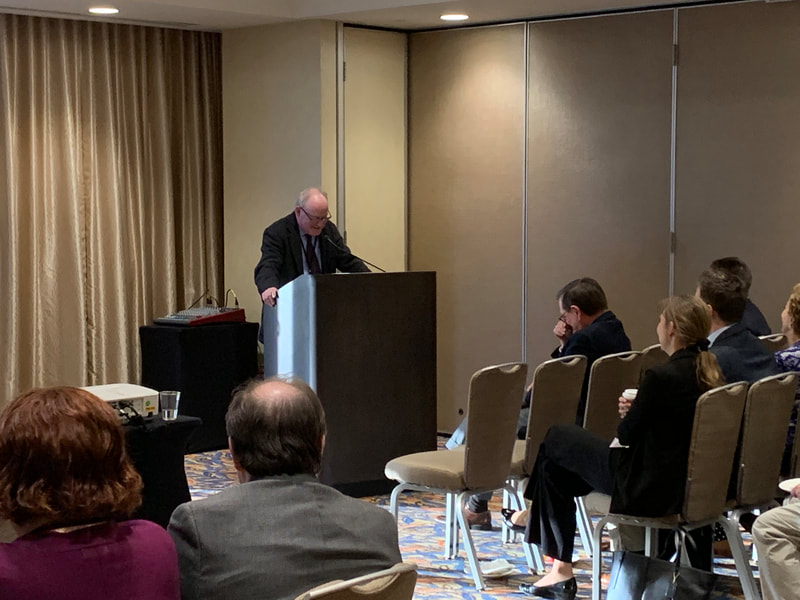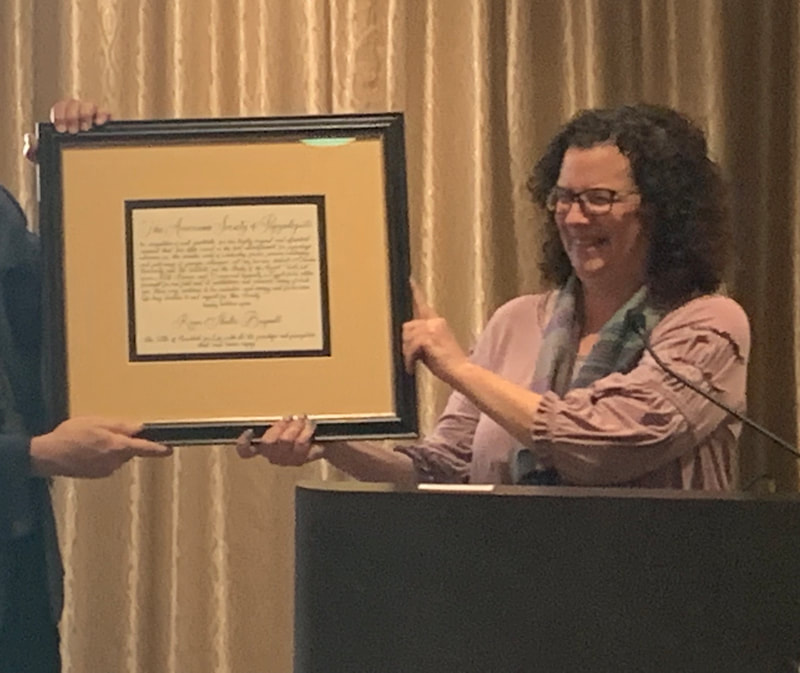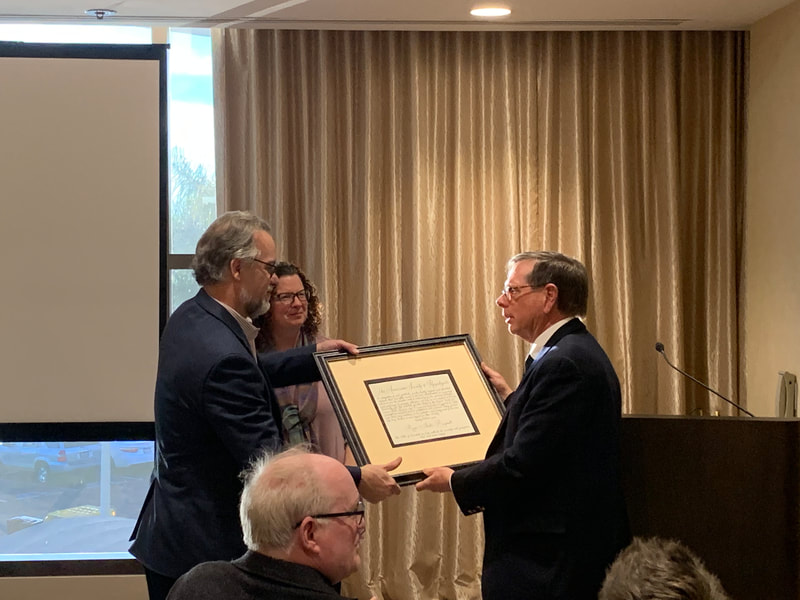Mission
The ASP was founded in 1961 to further the study of ancient Greek and Latin papyri and of the materials contained in them. The Society supports and encourages research in the field, the teaching of the discipline, and international cooperation by scholars. ASP publishes The Bulletin of the American Society of Papyrologists (BASP), the only North American journal in the field of papyrology, and three book series. We also organize annual panel sessions at both the Society for Classical Studies and the Society for Biblical Literature, sponsor biennial summer institutes for training scholars in papyrology, and facilitate a triennial papyrological workshop (the North American Papyrological Seminar).
Announcements
Meetings & Seminars |
News & Events |
|
Each year, the American Society of Papyrologists holds its Annual Meeting in early January in conjunction with the Joint Annual Meeting of the Society for Classical Studies (SCS) and the Archaeological Institute of America.
As part of the Annual Meeting, the ASP sponsors a panel of between three and five papers on a wide range of subjects within the field of papyrology. Submissions are welcome from all interested parties; membership in the ASP is not required, although it is strongly encouraged. However, since the ASP Annual Meeting is a part of the official SCS program, speakers must be members in good standing of the SCS. Also, speakers are held to the SCS's single appearance policy, i.e. individuals can appear only once on the SCS program. If you wish to submit a paper for the next Annual Meeting, a short abstract (600 words) should be sent to Giovanni Ruffini by February 15. Abstracts are refereed anonymously, and decisions made by the end of March. Speakers will be asked to submit camera-ready abstracts to the SCS during the summer. Each paper is limited to 15 minutes (approximately 1875 words) and may use audio-visual equipment if necessary (this should be indicated on the abstract). Reminders of the deadline for abstracts will be in the SCS Newsletter in October and will also be posted on the PAPY list. Last Updated: (Tuesday, 03 May 2016 23:00) SOCIETY OF BIBLICAL LITERATURE PANEL:
PAPYROLOGY AND EARLY CHRISTIAN BACKGROUNDS The Papyrology and Early Christian Backgrounds Group explores how the ancient papyri illumine the world of early Christianity and will appeal to scholars interested in palaeographic, linguistic, and textual questions, as well as those who specialize in the social and cultural history of early Christianity. Questions and abstract submissions for the next panel should be directed to Lincoln H. Blumell of Brigham Young University. Last Updated: (Saturday, 05 November 2016 02:19) Since 2003, the American Society of Papyrologists has helped organize routine intensive summer programs in papyrology, on what we hope will now be a regular biennial program. For more information on the summer institutes, visit our Summer Institute page. INTERNATIONAL CONGRESS OF PAPYROLOGY
The next papyrological congress will be held in July 2019 in Lecce. Watch this space for more information as it becomes available. Last Updated: (Tuesday, 08 November 2016 02:09) The second North American Papyrology Seminar (NAPS) is scheduled to take place at Brigham Young University in Provo, Utah on 17-19 May 2018. NAPS was instituted as a two-day seminar for workshopping work-in-progress and presenting new work in a venue that’s a little bit dressed down. The first event, held in May 2015 in Ann Arbor, was a “rousing success.” The faculty and administration of BYU are eager to repeat it. Click here to find their Call For Papers
and address all inquiries to Roger Macfarlane ([email protected]). Besides offering the chance to mingle with papyrologists, Utah in mid-May can be very inviting to people who hike in the mountains above Provo and enjoy the red rock landscapes in not too distant national parks — Bryce Canyon, Zion, Arches, Canyonlands. |
Jan. 2019 - CALL FOR PAPERS - Culture and Society in Greek, Roman, and Byzantine Egypt - @ SCS Washington DC- DEADLINE Feb. 15!
The American Society of Papyrologists invites proposals for papers for its panel ="Culture and Society in Greek, Roman, and Byzantine Egypt" at the 2020 meeting of the Society for Classical Studies in Washington, DC (2-5 January). Although the scope of papyrological studies is wide, submissions for this panel must meet at least one of the following criteria: (a) they must deploy evidence for ancient literary cultures that is preserved on papyri, ostraka, or wooden tablets (in Greek, Latin, Coptic, demotic Egyptian, Arabic, or other pertinent languages); (b) they must investigate aspects of the histories or cultures of Egypt from the Hellenistic to the early Islamic period. Submissions from graduate students and faculty at all levels are welcome. *Prospective speakers must be members in good standing of the SCS*; please see https://classicalstudies.org/membership for membership information. Please send abstracts to Giovanni Ruffini, [email protected], by 15 February 2019. Abstracts should not exceed 600 words and should not include the author's name to ensure anonymous review. Prospective speakers may not submit more than one abstract for consideration. If sent by regular mail, abstracts should be postmarked by 15 February 2019 and addressed to Giovanni Ruffini, Fairfield University Department of History, 1073 North Benson Road, Fairfield, CT 06824 USA. Jan. 2019 - The Next SUMMER INSTITUTE IN PAPYROLOGY WILL TAKE PLACE AT THE UNIVERSITY OF CINCINNATI in June 2020
Professor Peter van Minnen will host the next Summer Institute in Papyrology at the University of Cincinnati. The co-leader of the Institute will be Jean Luc Fournet, Professor at the Collège de France. More details on the Institute and applications will be forthcoming closer to the time. Jan. 2019 - Roger Bagnall Appointed Honorary President-for-life
TExt of THE citation
THE AMERICAN SOCIETY OF PAPYROLOGISTS In recognition of and gratitude for his highly original and influential research that has often served as the best advertisement for papyrology’s relevance for the broader world of scholarship; for his generous mentorship and patronage of younger colleagues, not only his own students at Columbia University and the Institute for the Study of the Ancient World, but across North America and Europe and especially in Egypt; for his selfless foresight for our field and its institutions and resources, many of which owe their very existence to his initiative and energy; and for his near life-long devotion to and support for this Society hereby bestows upon Roger Shaler Bagnall the title of President for Life, with all of the privileges and prerogatives that said honor enjoys. Jim Keenan's address in Bagnall's honor
{Jim Keenan Address} For Roger S. Bagnall, in celebration of his being named Honorary President-for-Life of the American Society of Papyrologists, San Diego, CA, 4 January 2019 When Todd asked me to say a few words on this occasion, unfortunately delayed because of last year’s Boston blizzard, although the invitation came across as so casual, it was for me a cause for panic, a deer-in-the-headlamps moment: caught, no way out. The terror came from the obvious challenge: how to fashion a testimony of what Roger has meant to the American Society of Papyrologists and not fall short in mentioning all those contributions, the reality that lies behind his formal installation as Honorary President; even more difficult, how to gauge his moral influence on the Society over time—the auctoritas that has left no trace on paper or in cyberspace. Upon recovery from first shock, I meditated on the famous query of an immortal philosopher, Alfred E. Neuman: “What, me worry?” If this fails, I thought, the audience will surely blame Todd’s choice, not your execution. And, on further thought, it seemed best, since many of us papyrologists also fancy ourselves as historians, to try to put today’s award in the context of the Society’s history, even going back to 1961, its year of foundation. The spirit of that creational time is nicely captured by Gabrielle Stewart in her “History” of the ASP on the Society’s website, researched and written under William Johnson’s guidance. From this, it is amply clear that the driving forces behind the organization’s inception and early years were centered at Yale University; and if the idea, or the inspiration, belonged to Professor of Classics and Ancient History C. Bradford Welles, the agent for implementation was his student, the brilliant, energetic, mercurial Alan Edouard Samuel. Welles became our first sitting president, serving from 1961 until 1964, Samuel our first secretary-treasurer, serving from 1961 until 1972. The list of the Society’s initial 25 members was 44% Yalie: three faculty members (Welles, Samuel, John Oates), five Yale Ph.D.'s (Allan Evans, Bob Fink, Frank Gilliam, Verne Schuman, Vera Vanderlip), and three then current graduate students (Zola Clark, Deborah Hobson, Paul Swarney). None of us in this room today is on that list, not even Roger; but he did witness the early years of the Society, beginning with his matriculating at Yale in Fall 1964. In our joint recollection, it was in Fall 1965, when we were both in Alan Samuel’s class on 5th century Athens, that Roger and I first came into each other’s orbit. In that academic year, during renovation of the landmark Phelps Hall, the Department of Classics was being housed in Winchester Hall, since demolished, just across the street from the Grove Street Cemetery, where Michael and Sophie Rostovtzeff lie buried. In 1966, after his terminal year at Yale, Samuel headed for Toronto. That summer, the department returned to Phelps, but Welles’s office with its comprehensive papyrology library and file cabinets full of offprints moved elsewhere, to a corner office on the first floor of the building at 1 Hillhouse Avenue, itself on a corner of Hillhouse and Grove. There, over the next two academic years, often in solitude, I drudged away on my dissertation on the names Flavius and Aurelius, entering data in 3 x 5 index cards. In the first of those years, that is, 1966-1967, John Oates, having returned from a year’s leave in England, would stop in after class, and in ominous prolepsis, light up a smoke, gaze at a papyrus, light up another, then flip through the Yale Daily News before heading home. In 1967, a year after Alan had gone to Toronto, John departed for Duke, thus leaving Welles bereft of two former student-confidantes and, evidently by design and preference, physically separated from his department. The following year, 1967-1968, as I remember, Welles would come in every day. If it was only brief a drop-in to check the mail, he would be accompanied by his dog, a springer spaniel; the dog’s name was Tinker. He would inevitably ask a question that always prompted from me a negative answer: “Have you seen Leslie?”[1] On any given afternoon, you would see Tim Renner vetting papyri that were housed in the big safe in Welles’s office-cum-library. Roger, or rather Rusty, as he was then known, would come in, change into comfortable shoes, and occupy an easy chair in the room’s alcove to catch up on the day’s news. He had spare time because, as he delights to tell it, he had been fired as curator of the departmental slide collection for covertly and, in the enemy’s point of view, subversively processing orders for the ASP’s first monograph, the Festschrift honoring Bradford Welles—effective insubordination. In summer 1968 the remnants of the hardcore papyrology crew at Yale—Tim, Roger, yours truly—dispersed, I to Berkeley, Tim to Michigan. Roger, notwithstanding his checkered employment record, eked out admission to a reputable graduate program, following Alan Samuel’s footsteps to Toronto. A year later, Welles’s death by heart attack spelled the end of papyrology at Yale for years to come. But by then the Society’s center of gravity, as embodied in the office of its secretary-treasurer, had shifted to Toronto. And while Alan Samuel remained in that office through the presidencies of Toli Lewis, Bill Willis, and Frank Gilliam, a pair of letters from Roger in my files prove he was already doing some of the secretary-treasurer’s work. It was therefore only natural in 1973 that, simultaneous with Alan’s ascension to the ASP presidency, Roger succeeded Alan as secretary-treasurer. Alan’s presidency ended in 1975, after which, ever the fox, never the hedgehog, his interests drifted away from papyrology and the Society and on to other enthusiasms; so that when Alan died in 2008, Roger rightly observed that the younger generation of papyrologists could have no idea what a force he had once been for the field as a whole and for the Society’s birth and toddler years. Meanwhile, Roger continued as secretary-treasurer until 1979; but it was 1973, the year of Alan and Roger’s joint succession to office that is of direct interest here today—because this was also the year in which the Society, now nearing adolescence, named as Honorary President Herbert Chayyim Youtie of the University of Michigan, one of the Society’s original 25 members. For such an honor there is no provision in our original constitution; but the constitution revised and approved just last year (February 19, 2018), at the end of Part II.1(b), enjoins the following: “On nomination of the Board of Directors the majority of the membership may elect from time to time Honorary Presidents for life (without specific duties).” I can only guess that this provision dates to 1973 and was enacted so as to pave the way for honoring Youtie, our first, and until now only, Honorary President. His is therefore the only name on our website under the rubric “Honorary Presidents”—please note the plural—as if anticipating additions to this list of one and saving ample space for Roger. The Stewart-Johnson “history” observes that the title was bestowed upon Youtie “in recognition of his pioneering work.” This is neatly and honestly put, and by such terms, that is, membership and scholarly distinction, Roger could have been so honored ages ago—all the more since he brings immeasurably more credentials to merit this honor than any other member in the Society’s history. I have already mentioned his surreptitious service without portfolio, his assistance to the sitting secretary-treasurer and subsequent occupying of the same position. But his connections then were, and now are, manifold. He was a student in the Society’s second Summer Institute, held in Philadelphia, in 1968. This led to his first scholarly publications, starting with the classic “An Order for Nails,” BASP 5: 2-3, October 1968, 99–103—in print only a few months after the SIP had ended. From such a small but prompt beginning, he has over time graced the pages of BASP with numerous articles [41], review articles [2], reviews [9], and obituaries [5]. His BASP supplements, the one with Klaas Worp on regnal formulas (1978), the other on currency (1985), remain relevant in today’s scholarly literature decades after publication. Roger was a co-compiler of the indispensable Checklist of papyrus editions, itself also originating as a BASP supplement. He has in some form or other contributed to nine of the Society’s monographs (10, 15, 20, 23, 28, 34, 40, 42, 51), and of course the 53rd and latest volume in the series (2013) is the one in his honor. I cannot fail to mention that when I was BASP editor in the late 1980s and early 1990s, after the Bulletin had graduated from producing copy by IBM Selectric to computerized production, Roger, for many of those issues, was the “typesetter” and a de facto co-editor. He once caught a serious mistake in one of Lionel Casson’s articles, and Casson in a note covering the proofs’ return wrote to me in relief, “Thank God for Roger.” Amen, we all say, to that. Roger succeeded me as ASP president in 1995, thereby playing FDR to my Herbert Hoover, . . . Lincoln to my Buchanan. Ever alert to the opportunities provided by the world of technology, it was during his presidency that he initiated with the late and still sorely lamented Traianos Gagos the project known as APIS, the Advanced Papyrological Information System. As you may know, the ASP’s presidency entails a preceding vice-presidency and succeeding past presidency and a seemingly eternal membership on the Board of Directors. It would be easier to tote up the years Roger was not on the Board than to add up those in which he was. And since from its inception the ASP was conceived of, in a way, as an offshoot to the International Association of Papyrologists [Association Internationale de Papyrologues], Roger’s presidency in that organization, presiding over the international congresses in Ann Arbor (2007) and Geneva (2010), can be conceived of as the culmination of his cursus honorum in papyrological organizations, a censorship following a consulship. Only Toli Lewis and Ludwig Koenen had held both presidencies before him. Roger was also instrumental in reigniting the Society’s Summer Institutes, which restarted in 2003—fittingly—at Yale. He was co-organizer and instructor in the SIP held at Columbia in 2006 and in the latest one, 2018, at Washington University, St. Louis. It is well known, he was a driving force behind establishing the SIP’s endowment fund. Not in the public record is that his personal and substantial financial support of the endowment through direct and indirect gifts has been critical for the its success. His latest gesture of generosity is the challenge grant in support of the Papyrological Navigator, the platform that has become the indispensable mega-tool for papyrological research. This therefore is a project in which the Society has considerable self-interest and will, in the envisaged practical arrangements, have considerable responsibility. I think, finally, that if a cadre of Martian intelligence agents would come down today to investigate an earthling named Roger Shaler Bagnall III, they would think they’d located two dozen of them, all with the same handle, all highly successful and eminently distinguished; but they’d be perplexed by the coincidence that they had—all 24 of them— been born in a place called Seattle, the same day, the same hour, indeed the same minute, in the year 1947—and a half dozen of said Bagnalls had faithfully and continually served in numerous capacities a certain strangely named organization. They’d know from analogous institutions on their own planet what Society meant. Eventually, upon further research, they’d grok onto the meaning of American as referencing, in one of its senses, a nation once greatly admired worldwide—but then they’d ask, “What the Venus” are these people called Papyrologists? While lingering over this question in puzzlement, they would nevertheless immediately conclude that whoever these six papyrological Bagnalls were, they each deserved to be named Honorary Presidents of this strange association—and for life. Imagine the buzz in their antennas when—finally—they learned that the six were—after all—only one remarkable individual. [1] I.e., Leslie S. B. MacCoull, apparently living in NYC that year. pictures of the event
OCT. 2018 - BASP 55 (2018) NOW AVAILABLE!
|
